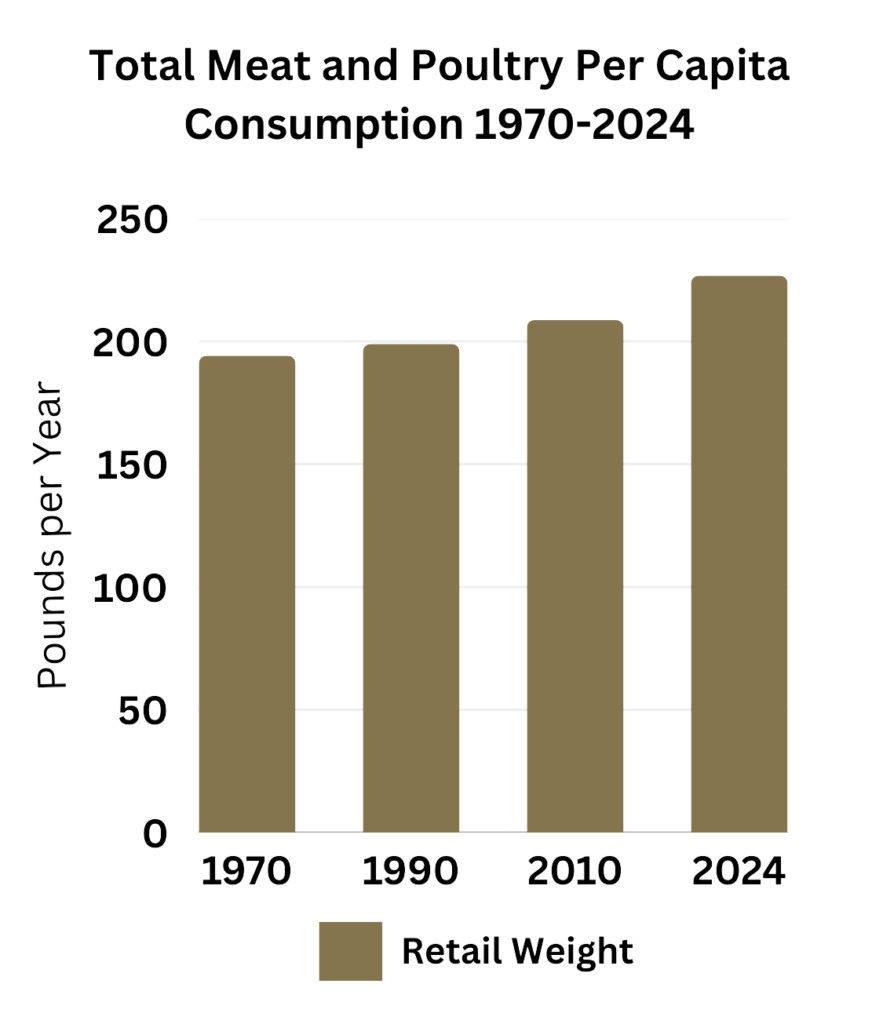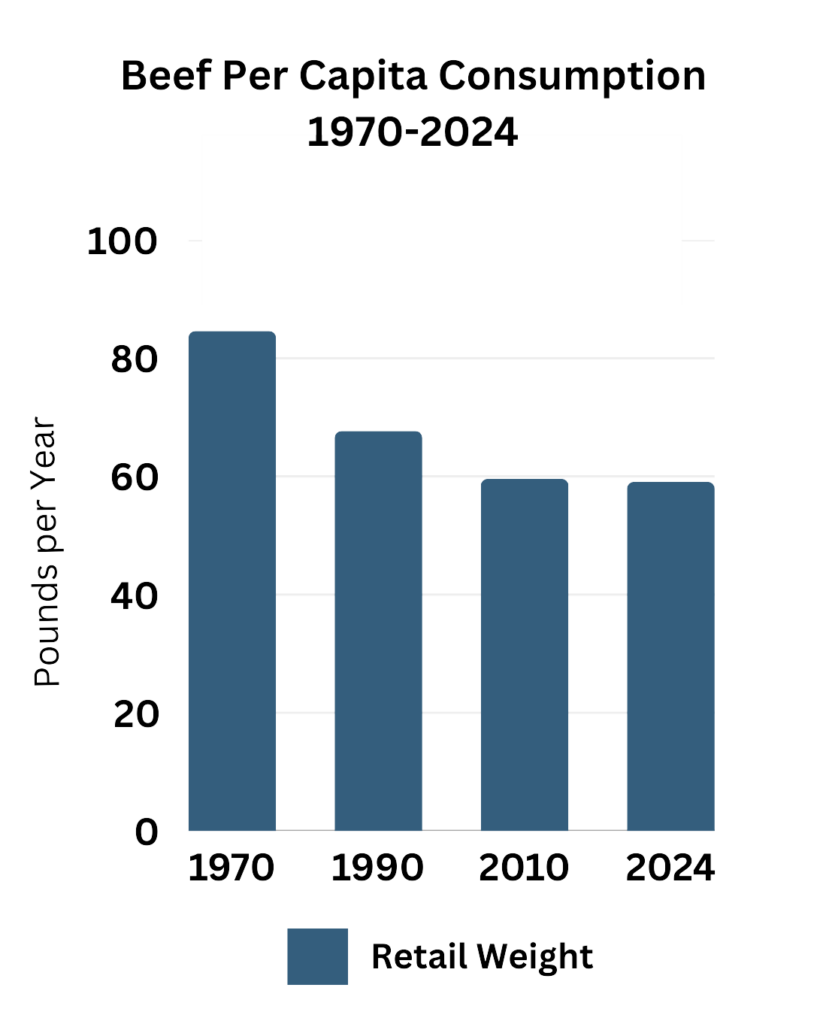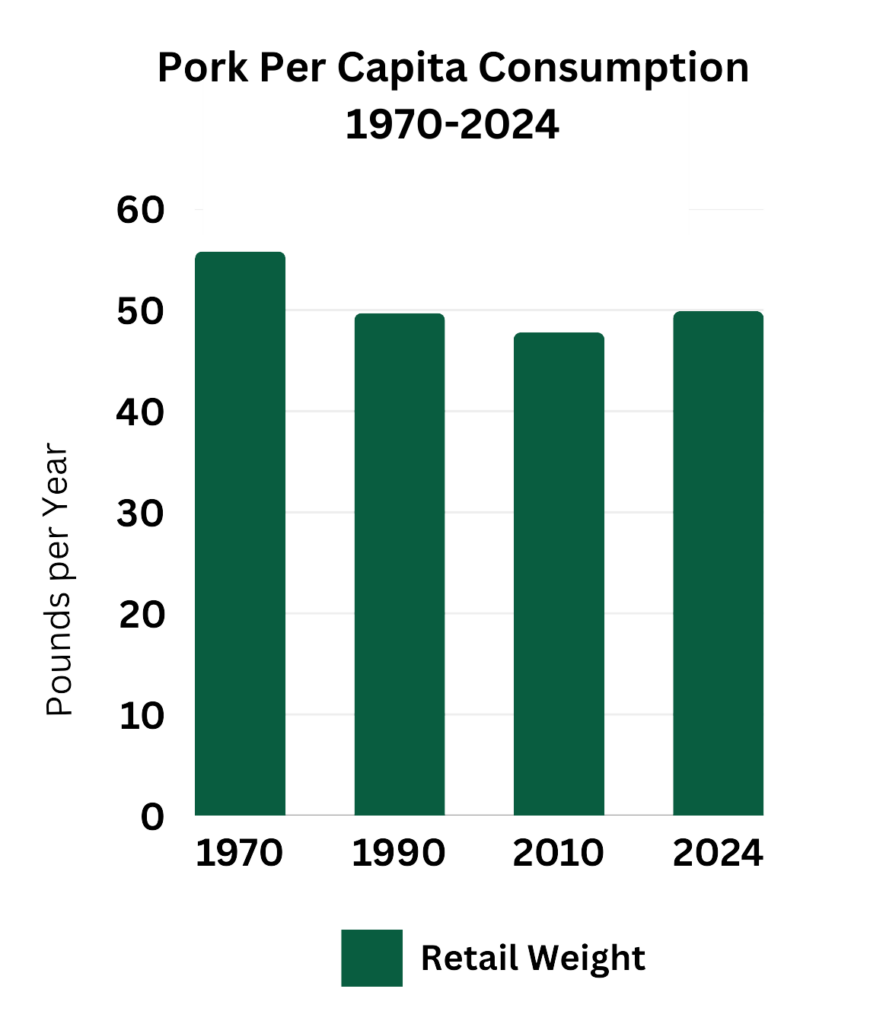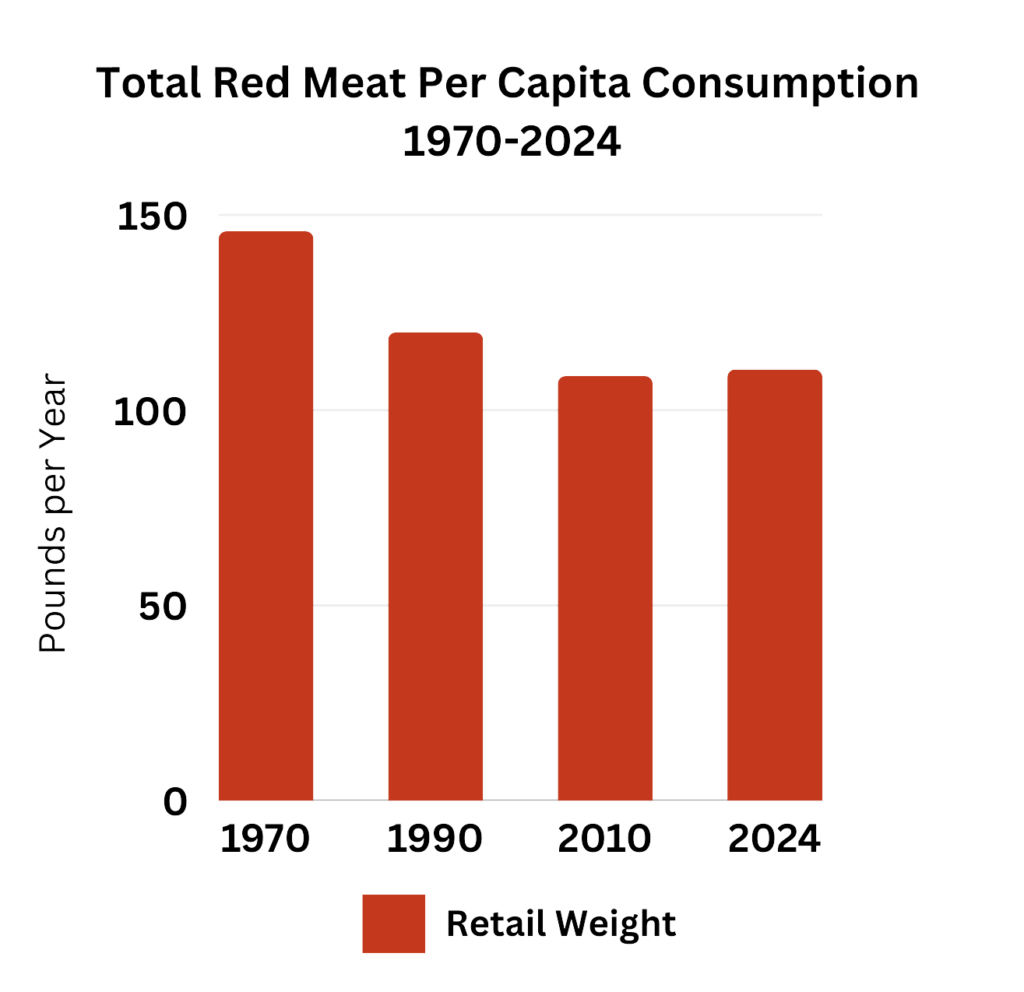In 2024, U.S. per capita total meat consumption: Retail weight = 227 lbs.[1]
Total per capita meat consumption has increased by ~17% from 1970.
It has increased by ~9% from 2010.
It has increased by ~1% from 2023 to its highest historical rate.[2]

The USDA’s “red meat” category includes beef, veal, pork, lamb and mutton.[3] The “poultry” category includes broilers, other chicken (egg-laying hens), and turkeys.[4] Together, they equal “total meat.”
The estimated “actual consumption” for 2024 (adjusted for all loss) equals ~141 lbs.[5]
USDA ERS (updated 3/21/25) Livestock and Meat Domestic Data. Table: Meat supply and disappearance tables, recent. Worksheet: Total red meat & poultry, Table 10. https://www.ers.usda.gov/data-products/livestock-and-meat-domestic-data/ [Retail weight includes bones and inedible parts, delivered to store or institution, after adjusting for loss from the slaughterhouse. As explained on 10B.1 Meat Consumption Data Overview, the retail weight figures reported on this page are the USDA’s “proxy” for consumption, which are, in fact, the availably of product at retail.]
USDA ERS (updated 3/21/25) Livestock and Meat Domestic Data. All supply and disappearance – Meat Supply and Disappearance, historical (through 2024). Total red meat & poultry, Table 10. [1970 = 194.2 lbs.; 1990 = 199 lbs.; 2010 = 208.8 lbs.; 2023 = 224.1 lbs.; 2024 = 226.8 lbs. A total 16.8% increase from 1970, 8.6% from 2010, and 1.2% from 2023]
USDA ERS (2024) Food Availability (Per Capita) Data System, Food Availability Documentation, See Glossary “red meat.”
See, Livestock and Meat Domestic Data. Table: Meat supply and disappearance tables [adding broilers, other chicken, and turkeys = total poultry]
We broadly estimate this figure based on 2024 primary/carcass weights and applying the USDA’s estimates of all loss-adjusted shares, primarily from 2019. See, https://docs.google.com/spreadsheets/d/1ppnDkCw7lAoWB_rnRlcn2CPpR4Qf0N1s/edit?gid=2910956#gid=2910956
In 2024, U.S. per capita beef consumption: Retail weight = 59.1 lbs.[1]
The trend in beef consumption:[2]

The estimated “actual consumption” for 2024 (adjusted for all loss) equals ~43 lbs.[3]
USDA ERS (updated 3/21/25) Livestock and Meat Domestic Data. Table: Meat supply and disappearance tables, historical (through 2024). Worksheet: Beef/Retail weight.
USDA ERS (updated 3/21/25) Livestock and Meat Domestic Data. Table: Meat supply and disappearance tables, historical (through 2024). Worksheet: Beef/Retail weight. [1970 = 84.6 lbs. ; 1990 = 67.7 lbs.; 2010 = 59.6 lbs.; 2024 = 59.1 lbs.]
We broadly estimate this figure based on 2024 primary/carcass weights and applying the USDA’s estimates of all loss-adjusted shares, primarily from 2019. See, https://docs.google.com/spreadsheets/d/1ppnDkCw7lAoWB_rnRlcn2CPpR4Qf0N1s/edit?gid=2910956#gid=2910956.
In 2024, U.S. per capita pork consumption: Retail weight = 49.9 lbs.[1]
The trend in pork consumption:[2]

The estimated “actual consumption” for 2024 (adjusted for all loss) equals ~32 lbs.[3]
USDA ERS (updated 3/21/25) Livestock and Meat Domestic Data. Table: Meat supply and disappearance tables, historical (through 2024). Worksheet: Pork/Retail weight.
USDA ERS (updated 3/21/25) Livestock and Meat Domestic Data. Table: Meat supply and disappearance tables, historical (through 2024). Worksheet: Pork/Retail weight. [1970 = 55.8 lbs.; 1990 = 49.7 lbs.; 2010 = 47.8 lbs.; 2024 = 49.9 lbs.]
We broadly estimate this figure based on 2024 primary/carcass weights and applying the USDA’s estimates of all loss-adjusted shares, primarily from 2019. See, https://docs.google.com/spreadsheets/d/1ppnDkCw7lAoWB_rnRlcn2CPpR4Qf0N1s/edit?gid=2910956#gid=2910956
In 2024, U.S. per capita total “red meat” consumption: Retail weight = 110.4 lbs.[1]
The trend in red meat consumption:[2]

The USDA categorizes “red meat” as including beef, veal, pork, lamb, and mutton.[3]
The estimated “actual consumption” for 2024 (adjusted for all loss) equals ~76 lbs.[4]
USDA ERS (updated 3/21/25) Livestock and Meat Domestic Data. Table: Meat supply and disappearance tables, historical (through 2024). Worksheet: Total red meat/Retail weight.
USDA ERS (updated 3/21/25) Livestock and Meat Domestic Data. Table: Meat supply and disappearance tables, historical (through 2024). Worksheet: Total red meat/Retail weight. [1970 = 145.8 lbs.; 1990 = 119.9 lbs., 2010 = 104.2 lbs.; 2024 = 110.4 lbs.]
USDA ERS (2024) Food Availability (Per Capita) Data System, Food Availability Documentation, See Glossary “red meat.”
We broadly estimate this figure based on 2024 primary/carcass weights and applying the USDA’s estimates of all loss-adjusted shares, primarily from 2019. See, https://docs.google.com/spreadsheets/d/1ppnDkCw7lAoWB_rnRlcn2CPpR4Qf0N1s/edit?gid=2910956#gid=2910956
In 2024, U.S. per capita chicken (broilers and egg-laying hens) consumption: Retail weight = 102.6 lbs.[1]
The trend in chicken consumption:[2]

Chicken consumption continues to increase substantially in the past 10 years, going from ~85 lbs. in 2014 to ~103 lbs. in 2024. Most chickens consumed are broilers, with “other chicken” (egg-laying hens) a very small percentage.
The estimated “actual consumption” for 2024 (adjusted for loss) equals ~58 lbs.[3]
USDA ERS (updated 3/21/25) Livestock and Meat Domestic Data. Table: Meat supply and disappearance tables, historical (through 2024). Worksheets: Broilers and Other chicken/Retail weight. [Note: Broilers = 101; Other chicken (presumably egg-laying hens) = 1.6 lbs.]
USDA ERS (updated 3/21/25) Livestock and Meat Domestic Data. Table: Meat supply and disappearance tables, historical (through 2024). Worksheets: Broilers and Other chicken/Retail weight. [1970: Broilers = 36.6 lbs.; Other chicken (n/a); 1990: Broilers = 59.5; Other chicken (n/a); 2010: Broilers = 82.4 lbs.; Other chicken = 1.4 lbs.; 2024: Broilers = 101 lbs.; Other chicken = 1.6 lbs.]
We broadly estimate this figure based on 2024 primary/carcass weights and applying the USDA’s estimates of all loss-adjusted shares, primarily from 2019. See, https://docs.google.com/spreadsheets/d/1ppnDkCw7lAoWB_rnRlcn2CPpR4Qf0N1s/edit?gid=2910956#gid=2910956
In 2024, U.S. per capita total poultry consumption: Retail weight = 116.4 lbs.[1]
The trend in total poultry consumption:[2]

The estimated “actual consumption” for 2024 (adjusted for all loss) equals ~65 lbs.[3]
USDA ERS (updated 3/21/25) Livestock and Meat Domestic Data. Table: Meat supply and disappearance tables, historical (through 2024). Worksheet: Total Poultry/Retail weight. [Note: This category includes broilers, other chickens, and turkeys. It does not include ducks or other birds.]
USDA ERS (updated 3/21/25) Livestock and Meat Domestic Data. Table: Meat supply and disappearance tables, historical (through 2024). Worksheet: Total Poultry/Retail weight.[1970 = 48.4 lbs; 1990 = 79.1 lbs.; 2010 = 100.2 lbs.; 2024 = 116.4 lbs.]
We broadly estimate this figure based on 2024 primary/carcass weights and applying the USDA’s estimates of all loss-adjusted shares, primarily from 2019. See, https://docs.google.com/spreadsheets/d/1ppnDkCw7lAoWB_rnRlcn2CPpR4Qf0N1s/edit?gid=2910956#gid=2910956
Based on retail weights for each of the meat categories:[1]

Based on the estimated “actual consumption” figures for each of the meat categories:[2]

Notably, and contrary to common understanding,[3] poultry consumption is smaller than red meat when considering “actual consumption.” This is because poultry is usually sold with bones, while red meat is usually sold without bones. The common usage of retail weights (with bones) for determining consumption makes it appear that poultry is the majority of consumption.[4]
USDA ERS (updated 3/21/25) Livestock and Meat Domestic Data. Table: Meat supply and disappearance tables. [Beef = 59.1 lbs.; Pork = 49.9 lbs.; Other red meat = 1.4 lbs.; Chicken = 102.6 lbs. (broilers and other chicken); Turkey = 13.8 lbs.]
We broadly estimate these figures based on 2024 primary/carcass weights and applying the USDA’s estimates of all loss-adjusted shares from 2019. See, https://docs.google.com/spreadsheets/d/1ppnDkCw7lAoWB_rnRlcn2CPpR4Qf0N1s/edit?gid=2910956#gid=2910956
USDA ERS (February 2025) Livestock, Dairy, and Poultry Outlook: February 2025, p. 1. [“Broiler meat is the most consumed animal product, and per capita consumption has been growing for many years; it is projected to be 103.1 pounds in 2025.”]
USDA ERS (updated 3/21/25) Livestock and Meat Domestic Data. Table: Meat supply and disappearance tables, recent (through 2024). [Broilers retail weight = 101.0 lbs.; Boneless = 70.8 lbs. (29.9% reduction). Beef 59.1 to 56.5 (4.4% reduction). Pork 49.9 to 46.9 = 6.0% reduction.]
